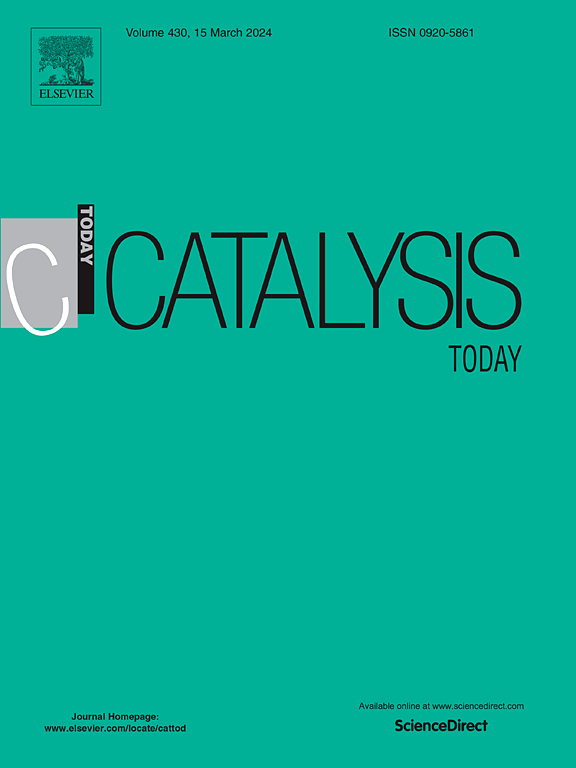以六方介孔二氧化硅为载体的镍氧化铝催化剂在水中与异丙醇水溶液为溶剂进行木糖到木糖醇的可持续氢化反应
IF 5.2
2区 化学
Q1 CHEMISTRY, APPLIED
引用次数: 0
摘要
将木糖加氢转化为木糖醇具有商业吸引力。本研究以水和异丙醇水溶液为溶剂,并使用新型强效催化剂为目标。这项研究表明,六方介孔二氧化硅(HMS)支撑的镍-氧化铝催化剂可以有效地将木质纤维素衍生的木糖部分转化为高附加值产品木糖醇。通过同时浸渍镍(6 wt%)和氧化铝(4 wt%)对 HMS 载体进行改性,然后对其进行氧化。对该催化剂将木糖氢化为木糖醇的能力进行了评估。用 HMS、氧化铝、Al/HMS 和 Ni/HMS 进行了相同的反应,以确定每个分子在反应中的活性。反应前,催化剂在有氢气存在的管式反应器中进行还原。对搅拌速度、前驱体类型、金属负载、催化剂负载、溶剂、浓度和温度等反应参数进行了研究和优化。在 130℃ 和 20 bar H2 条件下,以水:异丙醇(1:1 v/v)混合物为溶剂,木糖初始浓度为 0.2 mmol/mL,木糖转化率为 98%,对木糖醇的选择性为 97%。此外,还与单独用水作为溶剂进行了比较。对反应进行了动力学研究。使用这种新型催化剂将木糖转化为木糖醇是一种绿色工艺,因为与传统的雷尼镍催化剂相比,这种催化剂的金属负载量要低得多,而且不需要使用铂、钯、铑或钌等贵金属,也没有金属浸出的问题,因此比目前报道的催化剂更为优越。本文章由计算机程序翻译,如有差异,请以英文原文为准。
Sustainable hydrogenation of xylose to xylitol using nickel-alumina catalysts supported on hexagonal mesoporous silica in water vis-à-vis aqueous isopropanol as solvent
Hydrogenation of xylose to xylitol is commercially attractive. The use of water as well as aqueous isopropanol as solvent using a novel robust catalyst was targeted in this work. This work showed that a nickel-alumina catalyst supported on hexagonal mesoporous silica (HMS) can effectively transform lignocellulose-derived xylose fraction to the value-added product, xylitol. HMS support was modified by simultaneous impregnating nickel (6 wt%) and alumina (4 wt%) which was subsequently oxidized. The catalyst was evaluated for its hydrogenation ability of xylose to xylitol. Identical reactions were carried out with HMS, alumina, Al/HMS and Ni/HMS to ascertain the activity of each moiety in the reaction. Before the reaction, the catalyst was reduced in a tubular reactor in the presence of hydrogen. Reaction parameters such as speed of agitation, type of precursor, metal loading, catalyst loading, solvent, concentration and temperature were studied and optimized. At 130℃ and 20 bar H2, initial xylose concentration of 0.2 mmol/mL with water: isopropanol (1:1 v/v) mixture as solvent, conversion of xylose was found to be 98 % with a selectivity of 97 % towards xylitol. Comparison was also made with water alone as a solvent. A kinetic study of the reaction was performed. The transformation of xylose to xylitol using this novel catalyst is a green process since it entails substantially lower metal loading when compared to the conventional Raney nickel catalysts, it does not involve the use of noble metals such as Pt, Pd, Rh or Ru, and also does not suffer from the problem of metal leaching, making it superior to those catalysts reported yet.
求助全文
通过发布文献求助,成功后即可免费获取论文全文。
去求助
来源期刊

Catalysis Today
化学-工程:化工
CiteScore
11.50
自引率
3.80%
发文量
573
审稿时长
2.9 months
期刊介绍:
Catalysis Today focuses on the rapid publication of original invited papers devoted to currently important topics in catalysis and related subjects. The journal only publishes special issues (Proposing a Catalysis Today Special Issue), each of which is supervised by Guest Editors who recruit individual papers and oversee the peer review process. Catalysis Today offers researchers in the field of catalysis in-depth overviews of topical issues.
Both fundamental and applied aspects of catalysis are covered. Subjects such as catalysis of immobilized organometallic and biocatalytic systems are welcome. Subjects related to catalysis such as experimental techniques, adsorption, process technology, synthesis, in situ characterization, computational, theoretical modeling, imaging and others are included if there is a clear relationship to catalysis.
 求助内容:
求助内容: 应助结果提醒方式:
应助结果提醒方式:


